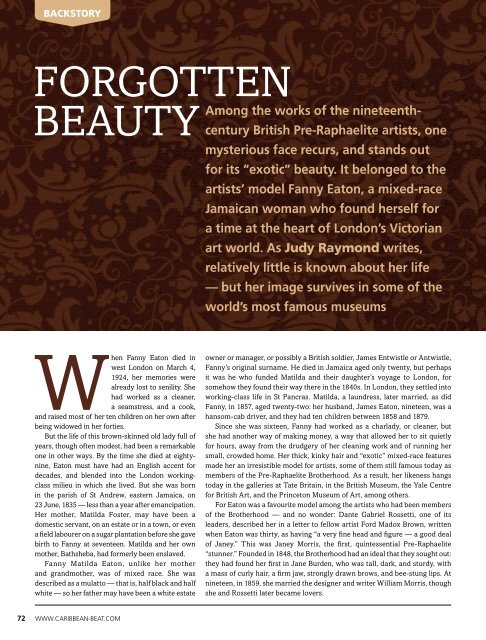Caribbean Beat — January/February 2017 (#143)
A calendar of events; music, film, and book reviews; travel features; people profiles, and much more.
A calendar of events; music, film, and book reviews; travel features; people profiles, and much more.
Create successful ePaper yourself
Turn your PDF publications into a flip-book with our unique Google optimized e-Paper software.
BACKSTORY<br />
Forgotten<br />
beauty<br />
Among the works of the nineteenthcentury<br />
British Pre-Raphaelite artists, one<br />
mysterious face recurs, and stands out<br />
for its “exotic” beauty. It belonged to the<br />
artists’ model Fanny Eaton, a mixed-race<br />
Jamaican woman who found herself for<br />
a time at the heart of London’s Victorian<br />
art world. As Judy Raymond writes,<br />
relatively little is known about her life<br />
<strong>—</strong> but her image survives in some of the<br />
world’s most famous museums<br />
When Fanny Eaton died in<br />
west London on March 4,<br />
1924, her memories were<br />
already lost to senility. She<br />
had worked as a cleaner,<br />
a seamstress, and a cook,<br />
and raised most of her ten children on her own after<br />
being widowed in her forties.<br />
But the life of this brown-skinned old lady full of<br />
years, though often modest, had been a remarkable<br />
one in other ways. By the time she died at eightynine,<br />
Eaton must have had an English accent for<br />
decades, and blended into the London workingclass<br />
milieu in which she lived. But she was born<br />
in the parish of St Andrew, eastern Jamaica, on<br />
23 June, 1835 <strong>—</strong> less than a year after emancipation.<br />
Her mother, Matilda Foster, may have been a<br />
domestic servant, on an estate or in a town, or even<br />
a field labourer on a sugar plantation before she gave<br />
birth to Fanny at seventeen. Matilda and her own<br />
mother, Bathsheba, had formerly been enslaved.<br />
Fanny Matilda Eaton, unlike her mother<br />
and grandmother, was of mixed race. She was<br />
described as a mulatto <strong>—</strong> that is, half black and half<br />
white <strong>—</strong> so her father may have been a white estate<br />
owner or manager, or possibly a British soldier, James Entwistle or Antwistle,<br />
Fanny’s original surname. He died in Jamaica aged only twenty, but perhaps<br />
it was he who funded Matilda and their daughter’s voyage to London, for<br />
somehow they found their way there in the 1840s. In London, they settled into<br />
working-class life in St Pancras. Matilda, a laundress, later married, as did<br />
Fanny, in 1857, aged twenty-two: her husband, James Eaton, nineteen, was a<br />
hansom-cab driver, and they had ten children between 1858 and 1879.<br />
Since she was sixteen, Fanny had worked as a charlady, or cleaner, but<br />
she had another way of making money, a way that allowed her to sit quietly<br />
for hours, away from the drudgery of her cleaning work and of running her<br />
small, crowded home. Her thick, kinky hair and “exotic” mixed-race features<br />
made her an irresistible model for artists, some of them still famous today as<br />
members of the Pre-Raphaelite Brotherhood. As a result, her likeness hangs<br />
today in the galleries at Tate Britain, in the British Museum, the Yale Centre<br />
for British Art, and the Princeton Museum of Art, among others.<br />
For Eaton was a favourite model among the artists who had been members<br />
of the Brotherhood <strong>—</strong> and no wonder: Dante Gabriel Rossetti, one of its<br />
leaders, described her in a letter to fellow artist Ford Madox Brown, written<br />
when Eaton was thirty, as having “a very fine head and figure <strong>—</strong> a good deal<br />
of Janey.” This was Janey Morris, the first, quintessential Pre-Raphaelite<br />
“stunner.” Founded in 1848, the Brotherhood had an ideal that they sought out:<br />
they had found her first in Jane Burden, who was tall, dark, and sturdy, with<br />
a mass of curly hair, a firm jaw, strongly drawn brows, and bee-stung lips. At<br />
nineteen, in 1859, she married the designer and writer William Morris, though<br />
she and Rossetti later became lovers.<br />
72 WWW.CARIBBEAN-BEAT.COM


















